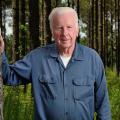Agroforestry
 Agroforestry is a land-use system that integrates spatial and rotational growth of woody perennials with herbaceous growth and/or livestock. Trees and other biotic components of the system interact both economically and environmentally.
Agroforestry is a land-use system that integrates spatial and rotational growth of woody perennials with herbaceous growth and/or livestock. Trees and other biotic components of the system interact both economically and environmentally.
Agroforestry can be used to supplement and diversify income, reduce financial risk for landowners, create excellent markets for wood and non-wood products, and meet consumer demand for specialty products.
Many agroforestry practices lead to improvements in wildlife habitat quantity and quality versus the large, cleared areas typical of monoculture-based agricultural practices. The creation of wildlife habitat can further supplement landowner income through hunting leases, provide personal satisfaction through wildlife-related activities, and increase the overall aesthetic quality of the land base.
Presently in the United States, the five major agroforestry practice systems in use are: windbreaks or shelterbelts, alley cropping, riparian buffer strips or zones, forest farming, and silvopasture. In the South, the most common systems used are silvopasture, alley cropping, and riparian buffers.
Adoption and recognition of agroforestry systems as economically and enviromentally promising alternatives to traditional monocultural systems continues to grow, and future research by this and other institutions and agencies will further accelerate the spread of agroforestry concepts.
Publications
Success Stories
During his tenure as an engineer at Boeing, Ottis Bullock helped build machines that went into the air and to the moon, but he always had an interest in the trees that grew from the ground where he came of age.


